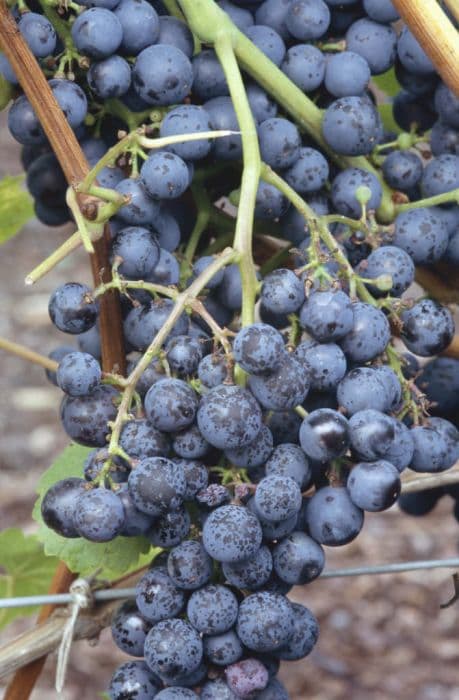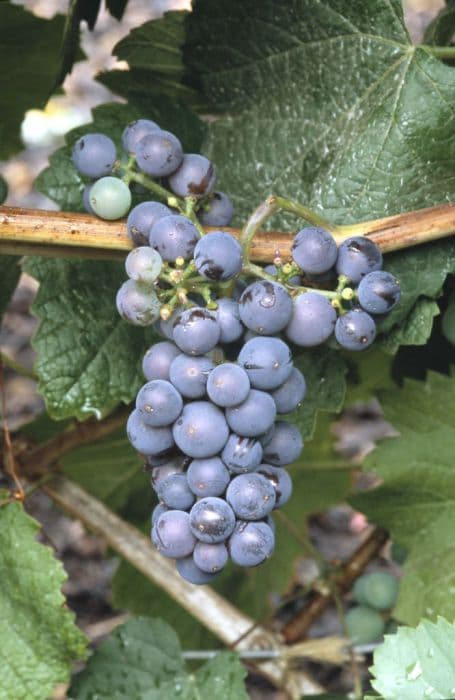Grape 'Siegerrebe' Vitis vinifera 'Siegerrebe' (O/w/d)

ABOUT
'Siegerrebe' is a moderately vigorous vine producing a moderate crop of white dessert grapes in the autumn. The size of the vine will depend upon the training method used
About this plant
 Names
NamesFamily
Vitaceae
Synonyms
Siegerrebe Grape
Common names
Vitis vinifera 'Siegerrebe'
 Characteristics
CharacteristicsLife cycle
Perennials
Foliage type
Deciduous
Color of leaves
Green
Flower color
Green
Height
4-6 feet (1.2-1.8 meters)
Spread
4-6 feet (1.2-1.8 meters)
Plant type
Climber
Hardiness zones
7
Native area
Europe
Benefits
 General Benefits
General Benefits- Ornamental Value: Adds aesthetic appeal to gardens with attractive foliage and grape clusters.
- Wine Production: Produces grapes suitable for making white wine with a distinct flavor.
- Shade Provider: Can be trained over pergolas or trellises to create shaded areas in gardens.
- Erosion Control: When planted on slopes, its root system stabilizes soil and helps prevent erosion.
- Habitat Support: Offers food and shelter for wildlife, particularly birds and beneficial insects.
- Pollinator Attraction: Flowers can attract bees and other pollinators, supporting local ecosystems.
- Edible Fruit: Produces grapes that can be eaten fresh, used in cooking, or for jelly and juice production.
- Seasonal Interest: Provides visual interest throughout the growing season with changing foliage and fruit development.
 Medical Properties
Medical PropertiesThis plant is not used for medical purposes.
 Air-purifying Qualities
Air-purifying QualitiesThis plant is not specifically known for air purifying qualities.
 Other Uses
Other Uses- As an ornamental vine: Vitis vinifera can be grown for its aesthetic appeal in gardens for its attractive foliage and bunches of grapes.
- In photography: The picturesque grape clusters can serve as a subject for close-up photography to capture the beauty of the vineyard.
- For shade and privacy: The dense foliage can provide natural shade and create a private space when planted over arbors, trellises, or pergolas.
- In culinary arts: Grape leaves can be used in cooking, for wrapping foods resembling the traditional dish of stuffed grape leaves, Dolma.
- Educational tool: Vitis vinifera can be used in educational settings to teach about plant biology, cultivation, and the history of winemaking.
- For dyeing: The skin of grapes contains natural pigments, which can be extracted and used for dyeing fabrics or other materials.
- As a craft supply: Dried grapevines can be used to create wreaths, baskets, or other rustic craft items.
- In composting: Grape pomace, the byproduct of grape processing, can be composted and used as a nutrient-rich soil amendment in gardens.
- For homemade vinegar: Unwanted or excess grapes can be fermented to produce homemade vinegar.
- As bird feed: Overripe or unwanted grapes from Vitis vinifera can be left on the vine to provide a food source for birds.
Interesting Facts
 Feng Shui
Feng ShuiThe grapevine is not used in Feng Shui practice.
 Zodiac Sign Compitability
Zodiac Sign CompitabilityThe grapevine is not used in astrology practice.
 Plant Symbolism
Plant Symbolism- Prosperity: As a type of grapevine, Siegerrebe is often associated with abundance and prosperity due to the historical significance of vineyards as signs of wealth and sustained yield.
- Fertility: Grapes are a symbol of fertility and growth, reflecting the nature of the vine to prolifically produce fruit.
- Transformation: The grape's ability to transform into wine is symbolic of transformation and transcendence, representing change and the ability to evolve.
- Joy: Grapes are commonly associated with wine, which in turn symbolizes celebration, joy, and conviviality in social gatherings.
- Vitality: The robust nature of grapevines and their hearty fruit represents vitality and health.
 Water
WaterGrapevines, like Siegerrebe, prefer deep, infrequent watering to encourage root development. During the growing season, they typically require about 1 inch of water per week, either from rainfall or supplemental irrigation. This translates to approximately 0.6 gallons per square foot per week. Water the vines early in the day to allow foliage to dry and reduce the risk of fungal diseases. Adjust the amount based on rainfall, and reduce watering as the grapes begin to ripen to help concentrate sugars in the fruit.
 Light
LightSiegerrebe grapevines thrive best in full sunlight, needing at least 6-8 hours of direct sun each day for optimal fruit production. The best spot for planting is in a south-facing location where the vines can receive abundant sunshine throughout the day. Avoid shady areas, as insufficient light can lead to poor fruit set and increased susceptibility to diseases.
 Temperature
TemperatureSiegerrebe grapevines perform well in a range of temperatures but prefer a temperate climate with hot summers and cool winters. They can tolerate winter lows down to around 20°F, but the ideal growing season temperatures range between 75°F and 85°F. Extended temperatures over 95°F may stress the vines, while temperatures below 50°F can impair fruit set.
 Pruning
PruningPruning is essential for maintaining healthy Siegerrebe grapevines and ensuring good fruit yield. Prune the vines during dormancy in late winter or early spring before new growth starts. Remove dead, damaged or diseased wood, and thin out overcrowded areas to improve air circulation. Aim to create a sturdy structure with well-spaced branches that allows light penetration, which is crucial for fruit development. Prune annually to ensure the plant's energy is directed towards producing high-quality fruit rather than excessive foliage.
 Cleaning
CleaningAs needed
 Soil
SoilThe grape variety Siegerrebe prefers well-draining soil rich in organic matter with a pH between 5.5 to 6.5. A mix of loam, compost, and peat with perlite or sand for drainage is ideal. Adjust soil acidity as needed to suit this range.
 Repotting
RepottingSiegerrebe grapevines typically do not require frequent repotting when grown outdoors, as they are usually planted directly in the ground. However, repot container-grown vines every 2-3 years to refresh the soil and accommodate root growth.
 Humidity & Misting
Humidity & MistingSiegerrebe grapevines are adaptable to a range of humidity levels and thrive best in outdoor environments where the humidity mirrors the local climate. They do not have specific humidity requirements but should be protected from excessively damp conditions to prevent disease.
 Suitable locations
Suitable locationsIndoor
Ensure ample light and space; prune regularly.
Outdoor
Full sun, well-drained soil, space for vines.
Hardiness zone
Siegerrebe is suitable for USDA zones 7-9.
 Life cycle
Life cycleVitis vinifera 'Siegerrebe', commonly known as Siegerrebe grape, begins its life cycle when the dormant vine awakens in spring with bud break, where tiny buds on the vine start to swell and eventually new shoots grow. These shoots evolve into mature vines bearing clusters of flowers which, following pollination, develop into small green berries. As summer progresses, the berries go through a growth stage known as veraison, where they enlarge and change color upon ripening. By late summer or early fall, the fully ripened grapes reach peak sugar levels and are harvested for wine production or table consumption. After harvesting, the vine leaves change color and fall off as the vine enters a period of dormancy during the colder months. To complete the cycle, the vine is pruned in winter to ensure healthy growth and crop yield in the following season.
 Propogation
PropogationPropogation time
Spring to Summer
Vitis vinifera 'Siegerrebe', commonly known as the Siegerrebe grapevine, is typically propagated through hardwood cuttings. This method is favoured due to its simplicity and effectiveness. Hardwood cuttings are taken during the plant's dormancy period in late winter. You would select healthy, mature canes from the previous season's growth and cut them into lengths of 12 to 18 inches (approximately 30 to 45 centimeters), ensuring each cutting has several buds. The cuttings are then planted in well-draining soil with the top bud just above the soil surface, where they will develop roots and eventually grow into new grapevines.









